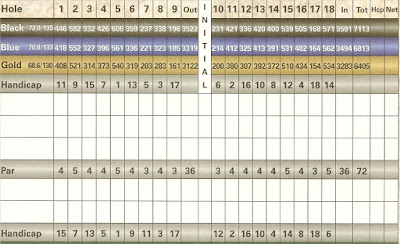Scorecard Playoffs: Breaking Ties in Golf (Matching Cards, Counting Back)
So-called scorecard playoffs are fairly common in golf for settling matches such as the one described above, or for breaking ties in a tournament setting (such as an association playday or charity event). There are several different ways to go about it, but the gist of a scorecard playoff is this: golfers compare scores on a selected hole (or holes), and the one with the lower score on that hole wins the "playoff."
That's why it's called a scorecard playoff: You are comparing scores that you've already recorded on your scorecard.
There are two main methods of conducting a scorecard playoff, plus a few other ways of doing it. We'll go over each of those now.
'Matching Scorecards,' Also Called a 'Match of Cards'
This is one of the two most-common ways of conducting a scorecard playoff (the other being "counting back," which follows below). Matching scorecards is also called matching cards or a match of cards. Golfers might say, "we don't have time to play extra holes, so let's match cards," or "we'll have to match scorecards for the playoff."Let's say our golfers are Emily and Juanita. They finished the 18th hole and are tied, so they are going to a match of cards. Matching scorecards involves using the handicap ranking of the golf holes. Look at the handicap row on the scorecard (often designated by "HCP") and find the No. 1 handicap hole. Now, both players check their score on that hole. If Emily scored 6 and Juanita scored 5 on the No. 1 handicap hole, then Juanita just won the "playoff."
If they also tied on the No. 1 handicap hole, then move on to the No. 2 handicap hole. And continue in that fashion until one player has a better score than the other on the given hole. That's a "matched scorecards playoff."
Just remember that when matching cards, you are starting with the hardest handicap hole (No. 1 on the handicap row of the scorecard), then on to the second-hardest, and so on.
Counting Back, aka 'The Countback Method'
Counting back on the scorecard, also called a countback playoff or the countback method, operates exactly the same as matching scorecards except that golfers do not use the handicap row. Instead, you start with the 18th hole and compare scores. If everyone tied on the 18th hole, then you go to the 17th, then to the 16th, and so on. You are counting back from the 18th hole.If Golfer A has a better score than Golfer B on the 18th hole, then Golfer A just won the "playoff." If not, count back to the 17th.
Other Ways of Doing a Scorecard Playoff
One can also do a random draw from a hat that has slips of paper marked 1 through 18. If, for example, the first paper drawn has the number "5" on it, then the golfers in the playoff compare scores on the fifth hole. No winner? Draw again. This method randomizes the selection of holes to compare, but does add a little bit of time to the process since you have to gather those slips of paper.Another way to do a scorecard playoff: Use the aggregate score for each golfer over the final three holes as the tiebreaker. If that doesn't settle it, go back another three holes.
Sticking with the theme of using groups of holes, you can break the tie based on the golfers' aggregate scores over the full back nine. If the back nine scores are also tied, start counting back from the ninth hole. And finally, another option is to compare scores made on the middle six holes of the 18-hole round. That means the aggregate totals the tied golfers made on holes 7 through 12.
